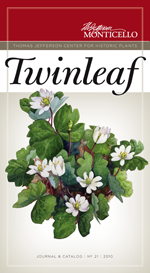
Thomas Jefferson's first documented mention of the word "Monticello" occurred in a terse August 3, 1767 notation in his horticultural diary, the Garden Book: "inoculated [a form of grafting] common cherry buds into [root] stocks of large kind at Monticello." This was his first mark on the land, two years before the red clay cellar was excavated for the South Pavilion. For the next fifty years, Thomas Jefferson's quest for the "precious refreshment" of fancy fruit continued to engage his "natural inclinations."
It was not uncommon for eighteenth-century American homesteaders to plant their orchards before beginning construction of their dwellings. Until 1820, and to a lesser extent until 1860, horticulture meant fruit growing for most Americans. Perhaps 90 percent of the plants sold by commercial nurseries before 1820 were fruit trees or soft fruit. Most of the garden literature before 1860 dealt with apples, peaches, and grapes; eighty-nine pomological books were published before 1860, about 300 between then and 1920. The first horticultural cultivars developed by Europeans in North America were fruit varieties: the Rhode Island Greening and Roxbury Russet apples were discovered in seventeenth-century New England while the Virginia White apple emerged around 1700.
The apple is an apt symbol for the diversity and complexity of America's melting pot culture. No cultivated fruit has so many delightful variations as the apple; there are almost as many apples as there are people, each with its own unique history and personality. A 1905 publication of the Government Printing Office, Nomenclature of the Apple, listed the names of approximately 17,000 apple varieties that appeared in nineteenth-century American publications. The apple is to America as the potato is to Ireland or the olive to Italy. "The apple," as Virginia pomologist James Fitz proudly proclaimed in 1872, "is our democratic fruit."
The apple was a standard, every-day fruit at Monticello. Cider was an integral part of the Jefferson dining tradition. He drank it with the main course of his meals and, from some reports, relished apple and mince pies for dessert. Jefferson's cultivation of the apple was exceptionally discriminating as he concentrated on only four varieties that were either unrivaled for cider-making -- Hewes' Crab and Taliaferro -- or as a dessert fruit for the table -- Newtown or Albemarle Pippin and Esopus Spitzenburg. His cultivation of only eighteen apple cultivars was surprisingly limited. Native apples were the finest expression of eighteenth and early nineteenth-century Virginia pomology, yet Jefferson, the experimental plant collector and pioneering proponent of the indigenous products of his native land, expressed little interest in assembling a varietal collection. Nevertheless, Jefferson's four favorite apples are a regal assembly of the finest American varieties of all time.
Peter J. Hatch, Director
Monticello Gardens and Grounds
January 1995